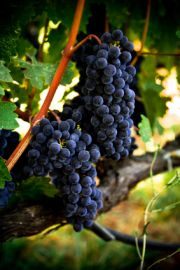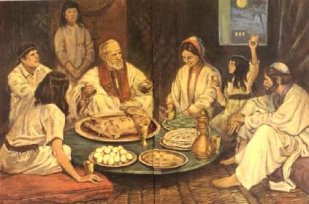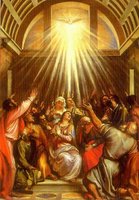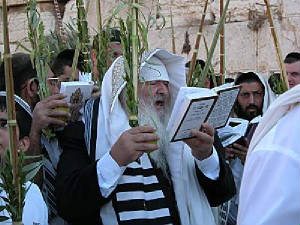Difference between revisions of "Biblical Festivals"
Elya Ghent (talk | contribs) |
|||
| Line 78: | Line 78: | ||
[[es:Festivales bíblicos]] | [[es:Festivales bíblicos]] | ||
[[ru:Библейские праздники]] | [[ru:Библейские праздники]] | ||
| + | [[ko:성경의 축제]] | ||
Revision as of 12:36, 24 January 2012
Festivals provide cultural anchors and milestones for people everywhere. They are compelling, and traditions surrounding them tend to pass from one generation to the next. The Lord knows this, so throughout biblical history He established festivals to anchor His people in gospel principles, and He has railed against festivals that lead His children astray.
The tendency of man from the beginning has been to attach festival celebrations to agricultural cycles and seasons. Thus, the traditional time of the celebration of Christmas has been erroneously scheduled to coincide with winter solstice, when the dead of winter is over and days begin to lengthen. Harvest, when crops have been gathered in, and people know there will be no starvation that winter, is a time for celebration in every culture. The onset of spring, when the earth is reborn, is a natural time to celebrate. Festivals logically celebrate the bounteous offerings of the earth (hence, water libations and wine fests), as well as fertility, both of the earth and the people who inhabit it.
Festival celebrations naturally attract accouterments over time—special foods, costumes, decorations, songs, music, and ritual behaviors. Mostly, these accouterments reinforce the symbolism of the holidays, such as the Easter egg, a symbol of rebirth. These extras that multiply as festivals are observed can sometimes obscure the original messages of the feasts, but they also offer so much attraction, that they can ensure loyal observance, too.
Contents
The Exodus
The Israelite exodus from Egypt was a 40-year walk through the Plan of Salvation—the Children of Israel were born from the womb of Egypt, through water (baptism), into a wilderness of testing, to inherit a promised land (eternal life). During this lengthy training period, the Lord, Jehovah, ordained seven holy convocations, or festivals, with the temple at the center of the festival rituals. These festivals were full of imagery and types that predicted the nature of the coming messiah, and indeed, laid out a map of religious history and futurity.
- Behold, my soul delighteth in proving unto my people the truth of the coming of Christ; for, for this end hath the law of Moses been given; and all things which have been given of God from the beginning of the world, unto man, are the typifying of him (2 Nephi 11:4).
Passover
The first of the seven festivals ordained by Jehovah through Moses was the Passover, in Hebrew–Pesach. The ritual was observed the night before the escape into the wilderness, and it is rich with imagery testifying of Christ as the redeemer and eternal sacrifice—the Lamb of God.
Passover was celebrated on the 14th of the Jewish month called Nisan, or Aviv. It was the first full moon after the spring equinox. Until then, the beginning of the year was celebrated in the fall, after final harvest, but the Lord moved it to the Passover. (Now, the religious year begins on this day, and the civil new year is still celebrated in the fall.) He required the faithful to take a perfect male lamb into their households on the tenth of Nisan. This gave the families four days to become completely attached to the darling animals before sacrificing them. The lamb typified Christ—it was to be sacrificed and prepared with no bones broken, and the sacrifice was to be completed between 3 and 5 in the afternoon—the time of Christ's crucifixion. The blood of the lamb was applied to the lintel of the doorway, typifying the saving blood of Christ, and that families can be saved together.
Christ was born (according to the Prophet Joseph Smith) in early April, Passover, like a lamb, in a stable. His atoning sacrifice occured on Passover, as well. Passover is a feast commemmorating deliverance, and Christ is the deliverer.
The Feast of Unleavened Bread
Passover anciently was one day, and it initiated The Feast of Unleavened Bread, which anciently lasted seven days. [1]
The Feast of Unleavened Bread brings into remembrance the deliverance from Egypt: the flight was so swift, bread dough baked in the sun before it had time to rise. The Passover ritual feast incorporates a piece of unleavened bread, or matzah, pierced and striped to keep it from rising, called the afikomon. The afikomon represents the messiah. It is wrapped in a white (or red) napkin and hidden early in the ritual, then resurrected and redeemed with a gift, all typical of Jesus as the Messiah. The Apostle Paul explained that leaven in the feast represented sin, and all sin was to be purged. All the festivals incorporate cleansing into their imagery.
Christ's Last Supper was a Passover feast, and He used the imagery He ordained as Jehovah to typify Himself. He used the afikomon as the first sacrament. Instead of looking forward to Messiah to come, men would now use the sacrament in remembrance of Christ's atonement. The Passover wine, representing joy, would now serve as a reminder of his blood atonment in the Garden of Gethsemane.
At the Last Supper, Jesus passed a cup of wine and the sacramental bread to His Apostles, but He did not partake Himself:
- And as they were eating, Jesus took bread, and blessed it, and brake it, and gave it to the disciples, and said, Take, eat; this is my body.
- And he took the cup, and gave thanks, and gave it to them, saying, Drink ye all of it;
- For this is my blood of the new testament, which is shed for many for the remission of sins.
- But I say unto you, I will not drink henceforth of this fruit of the vine, until that day when I drink it new with you in my Father’s kingdom (Matthew 26:26-29, emphasis added).
Christ promised to partake when the Kingdom of God in Heaven is joined with the Kingdom of God on earth. This will occur at the onset of the Millennium at a great gathering at Adam-ondi-Ahman, as described in Doctrine and Covenants 27:4-14.
Bikkurim
Bikkurim is a Hebrew word derived from "first-born son." It is a one-day festival celebrated "the day after the sabbath that occurs during the Passover week." Since the Jewish sabbath always occurs on Saturday, Bikkurim would fall on the Sunday occuring during Passover. Rabbis have debated this, wondering whether "sabbath" might mean the first day of Passover, which is a high sabbath. Often now, it is simply observed on the 16th of Nisan.
Passover is one of three pilgimage festivals, when all men were supposed to go up and bring offerings to the temple in Jerusalem. By spring, the first yield of barley had already been harvested, but the Israelites were not allowed to eat any of the newly harvested grain until Bikkurim. To prepare for the observance, a small field of grain was planted near the temple. It could not be watered, fed or cultivated; it had to grow up unto itself, in its own strength. Just before Bikkurim, three high priests would go down to the field, and with the common consent of a group of bystanders, choose a perfect sheaf of grain. The sheaf was set apart with a flaxen cord, harvested with prayer and thanksgiving, and then taken to the temple and offered as a "wave offering." It guaranteed a perfect future harvest.
This wave offering was offered as Christ rose again, the third day after His crucifixion, Sunday morning. Christ was the "first fruits of the resurrection," and He guaranteed a perfect harvest for the Lord—all men will be resurrected, both the righteous and the wicked.
In 1836, Elijah the Prophet, as a resurrected being, visited Joseph Smith and Oliver Cowdery in the Kirtland Temple. He restored the keys of his dispensation for this, the Last Dispensation of Time wherein there would be a "restoration of all things." His visit was on Sunday, during Passover week, on Bikkurim. He restored the sealing power, wherein all families could be sealed together for eternity, a perfect harvest unto the Lord. A place is set for Elijah at each Passover table, and he is ceremoniously welcomed as part of the ritual. Jews believe that Elijah will return, and that the Messiah will be close behind. The Church of Jesus Christ of Latter-day Saints proclaims that he has returned, and that the Messiah is "even at the door."
Counting the Omer
An omer is a measure of grain. For seven-times-seven weeks (49 days) the Israelites harvested their fields in fear and trepidation. During this season, Israel experiences hamsin, or sharav, winds from the deserts of the east, which bring depressing heat and sand, bad for crops.
Pentacost
Pentacost comes from the Greek word for fifty. Fifty days from Passover marks the next pilgrimage holiday, the Feast of Weeks, in Hebrew–Shavuoth. This is a festival of rejoicing in the harvest that brings to remembrance the giving of the Law (or Torah) at Mt. Sinai during the Exodus. The fulfillment of the holiday is the outpouring of the Holy Ghost upon the Apostles at Pentacost after the death of the Savior.
Feast of Trumpets
Another period of testing follows Pentacost, and then another triple-feast pilgrimage begins. In the early fall, the original time of the new year, the Feast of Trumpets is celebrated. It is also called Rosh HaShanah, new year. It commemmorates the creation of the earth. The trumpets warn that judgment day is nigh, and that there will be a separation of the righteous from the wicked before the Lord's final harvest. The trumpets call the righteous to awake, arise, and gather, that their names may be written in the Book of Life. The Angel Moroni delivered the Golden Plates to Joseph Smith on this holiday, fulfilling the imagery of warning and gathering the righteous.
Days of Awe
The Feast of Trumpets initiates a week of serious repentance in preparation for final judgment—Yamim HaNora'im. People must ask forgivness of those they have trespassed against and restore that which they've damaged through sin. They must abase themselves before the Lord and plead for forgiveness.
Day of Atonement
The Day of Atonement, or Yom Kippur, is the culmination of the term of repentance. In ancient days it entailed much sacrifice in the temple. Blood was everywhere, even on the veil of the Holy of Holies. It was the only day the High Priest entered into the Holy of Holies, and could utter the name of the Lord. A scapegoat was chosen upon which to cast the sins of the entire nation.
Feast of Tabernacles
Final judgment complete, mankind can rejoice. Sukkoth, or Tabernacles celebrates the ushering in of the millennial age. The flimsy booths are erected everywhere, and families eat, sleep and celebrate inside them. They represent the tents the Israelites dwelt in during the Exodus, but also the temple, the wedding canopy, the pavillion of the Lord. Anciently, the High Priests made circuits around the temple altar, uttering the Hosannah Shout. They waved palm branches to welcome the Messiah. On the Last Great Day, perfectly balancing Passover on the calendar, both meridians of the year, the year's festivals end, the final harvest is in, and life begins anew.
A water libation and fire ceremony were part of the ritual in ancient times. Christ went down to the water libation and declared Himself the living water. He also stood in front of the huge flaming menorah candlestick on the Temple Mount, and He declared Himself the light of the world.
Notes and References
- ↑ By the time of Christ, Pharisaic Jews had probably contracted the two holidays into a one-week festival, probably the reason Christ held His Passover supper one night early (Wednesday), and was crucified before the Pharisaic Passover (Thursday).
- Learn more at MormonBible.org




